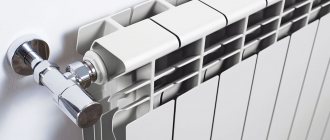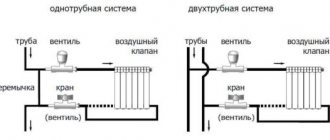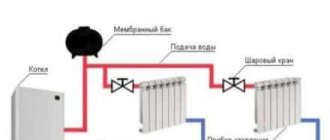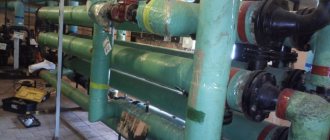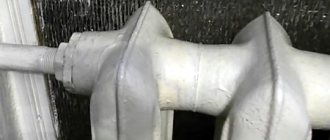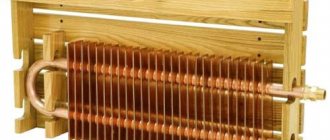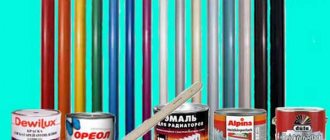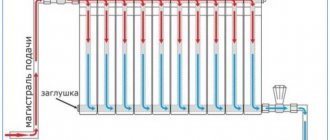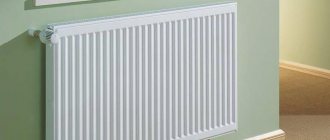Despite their higher cost, vertical heating radiators are gaining popularity. They allow you to organize heating of rooms with a non-standard layout, where it is quite difficult to install horizontal radiators.
This is an excellent solution for rooms with high ceilings of 4 m or more, since vertical structures enhance the convection of warm air to a much greater extent. Sometimes vertical radiators are simply an unusual, attention-grabbing design solution.
What are vertical heating radiators?
In apartments and private houses with a classic layout, it is customary to install batteries under the window sills. This is due to the fact that most radiators have a section height from 380 to 750 mm. To increase productivity (heat transfer), the number of sections is increased, increasing the effective surface.
Agree, it doesn’t look harmonious.
Recently, designers have been using new layout schemes, for example, panoramic glazing with minimal openings between windows. It is difficult to install convectors in such cases, and the appearance of the structure is not suitable for residential premises.
Another thing is the vertical design.
The situation can be corrected by installing high vertical radiators, which have a larger surface area and, therefore, more productivity.
Vertical radiators are usually called radiators whose height of sections significantly exceeds the width of the device.
Photos of classic and design solutions in the interior of the house
Zehnder Charleston 2180.
ZEHNDER 2180.
Purmo Delta 1500x200.
GUARDO PILON S4H.
Comparison of tall vertical batteries with horizontal ones: advantages and disadvantages
| Properties | Vertical radiators | Horizontal (classic) radiators | |
| Appearance | Designer execution | Designer execution or standard solutions for everyday tasks | |
| Temperature maintenance | Depends on the correctness of the calculations | ||
| Price | High | Average or budget | |
| Safety | High with the right choice of equipment | ||
| Life time | From 5 to 10 years warranty with the right choice of equipment | ||
| Manufacturability | Easy installation | ||
| Balancing | Requires experience with different radiators in the system | Simple | |
| Working and maximum pressure | Operating modes are taken into account when purchasing equipment | ||
The following are important for installers and the operating organization:
- manufacturability (ease) of installation and replacement;
- convenience of balancing the heating system in a private house;
- compliance of technical characteristics with operating conditions - type of coolant and maximum operating pressure.
Based on the totality of the evaluated parameters, it can be understood that vertical batteries have two important advantages over conventional radiators:
- an unusual appearance that adds style to the room and increases the status of the owner in the eyes of guests;
- ease of use for certain types of design.
The main disadvantage for the mass consumer is the high price of the product.
Experts note the difficulty of setting up the system if the composition includes different types of batteries - in this case, it is sometimes difficult to achieve the same flow of coolant through the convectors.
Installation features. Useful tips
Installing radiators yourself is not that difficult. It must be taken into account that vertical structures are more bulky and will take more time to install them under the ceiling. All wall-mounted heating devices, regardless of model and design features, are attached to the wall using brackets and connected either to the hot water pipeline or to the power supply network.
Important: if you are installing a new battery in place of an old one, first level the wall.
What you need to pay attention to when installing vertical heating devices:
- vertical models are heavier than horizontal ones, so they need to be placed only on a load-bearing wall;
- It’s good if you can hide the pipes in plasterboard structures or drown them in grooves. If not, bring the pipes to the bottom of the radiator. This way the design will look more aesthetically pleasing;
- install a jumper that regulates the heat intensity;
- be sure to install chokes and valves so that, if necessary, you can completely turn off the radiator;
- Do not combine copper pipes with aluminum. These metals form a galvanic couple in salt water conditions. Connect aluminum radiators to hot water supply using steel or propylene pipes;
- Aluminum models are not suitable for electrical systems. Current destroys metal much faster;
- the air vent is installed in the upper tube if the suspension is located at the bottom of the battery;
- propylene pipes installed below may not withstand the pressure due to the fact that it is concentrated at the bottom of the radiator. In this case, it is necessary to install a compensator to smooth out the expansion. Thus, the pipes are not deformed when exposed to high temperatures;
- If you need to paint batteries, choose only heat-resistant materials. This applies to both paints and varnishes.
Types depending on material of manufacture
Cast iron
Cast iron model Retro Style LILLE 813/95.
Reliable metal, practically not subject to corrosion. For manufacturing, a casting method is used, which makes surface treatment difficult. Because of this, the appearance of the products suffers.
Thick walls cause a large mass of the structure, which is inconvenient during transportation and installation. In addition, cast iron is not resistant to shock loads and is easily damaged when moved.
The maximum height of cast iron vertical radiators available for purchase can reach 1,000 mm, which is not so much to provide adequate heating in cold regions.
Wall-mounted options are placed only on durable external walls and solid partitions. The working pressure of cast iron radiators is, as a rule, 10 atm, and the pressure testing pressure is up to 15 atm. The devices can be used with any type of coolant heated to a temperature of 120 °C.
Steel
Steel model Purmo Delta Laserline 2180.
The ease of processing and the cost of metal make it possible to produce steel radiators in a low price category.
Steel products are made in the form of cast or tubular sections, as well as panels, between the walls of which coolant circulates.
Product advantages:
- low price;
- light weight, allowing installation on non-permanent walls;
- ease of installation;
- variety of appearance and colors;
- presence on the market of products with anti-corrosion treatment of internal surfaces.
Flaws:
- low operating pressure values - from 6 to 10 atm;
- accelerated corrosion of internal surfaces for inexpensive models, even despite anti-corrosion. coatings;
- welds that reduce strength.
How to choose steel heating radiators Design, selection criteria and best models
The main disadvantage is the impossibility of using it in multi-storey buildings with centralized heating, where the operating pressure can reach 10 atm, and the pressure test pressure can reach 15 atm. This property sometimes does not apply to tubular radiators, the characteristics of which may be suitable for such operating conditions.
Steel radiators are produced in three designs.
The model in the photo is Piano Vertical - TRC.
The first type (sectional) is a radiator in which identical sections are connected. By adding elements, you can form a battery of the required power.
Advice! It is not advisable to combine a large number of sections in a vertical radiator, since a large surface area contributes to increased cooling of the coolant. If there are several radiators in the circuit, then the latter will be filled with cooled coolant and the room will not warm up sufficiently.
The model in the photo is Zehnder Charleston 3180 Completto.
Tubular models are non-separable and in design, as a rule, are a set of individual pipes connected at the top and bottom by manifolds. Due to the lack of ribs, they have lower productivity compared to the sectional type. At the same time, they have an unusual appearance, which is often used in design projects.
Due to the absence of threaded connections, the tubular type is considered the most resistant to destruction during pressure testing and hydraulic shocks.
The inner surface of some models is coated with an anti-corrosion layer, which increases service life.
The model in the photo is Stelrad Vertex 10 300 1600.
Panel radiators can be of various designs.
The most common options are when steel pipes with circulating coolant are welded between two sheets. Modern models can be equipped with a front wall made of glass and mirror, which gives the room an exclusive appearance.
Aluminum
Aluminum OSCAR 1800/12 GLOBAL.
Aluminum radiators are comparable in price to steel ones, but are somewhat inferior to them in technical parameters.
For your information! Pure aluminum is rarely used for manufacturing due to the plasticity of the material. Silicon, copper and other chemical elements are added to the alloy to add strength.
Positive properties:
- low price;
- the minimum amount of coolant required to fill the system;
- light weight;
- fast heating and cooling, which helps to regulate the room temperature accurately and in a short period of time;
- high heat transfer coefficient, allowing to save energy resources in private homes;
- attractive appearance.
Among the disadvantages are:
- coolant leaks at the joints of sections after several years of operation due to thermal expansion of the alloy with temperature fluctuations;
- short service life;
- high activity of aluminum and the formation of gases during chemical reactions with the coolant.
Important! Aluminum radiators cannot be installed in multi-storey buildings with centralized heating due to low mechanical strength.
Bimetal
Bimetal model Royal Thermo PianoForte Tower Bianco Traffico.
So-called bimetallic batteries are one of the best vertical heating radiators for an apartment.
Structurally, the products consist of an inner tube made of stainless material (steel or copper), which is surrounded by an outer shell of aluminum.
This allows you to obtain a battery with technical characteristics suitable for use in any conditions: steel gives strength, and aluminum easily transfers heat and allows you to make the battery visually attractive.
Important! Externally, bimetallic batteries cannot be distinguished from aluminum ones, so when purchasing, be sure to clarify the information and require a product passport with a certificate.
Main dimensions
Dimensions mean:
The center-to-center distance (also called inter-nipple or center-to-center) should not be confused with the height of the heating radiator. The first indicator indicates how many centimeters are between the upper and lower collectors (holes). Height is the distance between the lowest and highest point of the section.
Aluminum heating radiators have the following dimensions:
- The center distance ranges from 150 to 2,000 mm. Very tall radiators are rare. The most popular are radiators with an inter-nipple distance of 500 mm. This is because the current heating network pipe system was created for cast iron batteries, which have the same center-to-center distance. Since many owners did not and do not have the desire to digest pipes, they simply selected/are selecting a suitable radiator and, thereby, increased the popularity of a battery with an interaxial distance of 0.5 cm. This indicator is very important, and therefore manufacturers indicate it in the name of the battery (RAP-500, Rococo 790, Magica 400, etc.).
- The height is in the range of 245-2000 mm. According to this criterion, batteries can be divided into low, medium and high. The features of each type will be discussed below.
- The section depth ranges from 52 to 180 mm. Some models may have greater depth, however, this is rare.
- The section width is 40-80 mm.
How to choose vertical heating radiators for an apartment or house
Minimum required power
To accurately calculate the required thermal power of radiators, complex calculations are required that take into account the climate in the region, the building material of the walls and the quality of their insulation. Be sure to take into account the height of the ceilings and the total volume of the room, the number and area of glazing, which side of the world the windows face.
How to accurately calculate the required boiler power Individual calculation, correction factors and online calculator
The simplest method of calculation is often used - it is believed that to heat a room with a ceiling height of 2.7 m, a radiator power of 100 W per 1 m2 is required. Thus, for a room of 20 m2, the total thermal power of the batteries is 2,000 W.
The passport of any product indicates the power of one section; it is necessary to purchase a radiator or several products in order to fulfill the calculation conditions. For example, if the documentation indicates that the power of one long section is 400 W, then for a room of 20 m2, purchase a radiator of at least 5 sections or 2 products of 3 sections each.
Allowable pressure
In private houses with autonomous heating, the heating boiler is usually protected from increased pressure, which is released through special valves. If necessary, establish a separate security group. Therefore, the pressure in the system does not exceed 3–4 atm for three-story buildings.
Taking this indicator into account, purchase batteries that can withstand such values. Almost any product is suitable for a private home.
In high-rise buildings, the operating pressure reaches 12 atm, and water hammer can be up to 16 atm - this is taken into account when purchasing. If the convector is destroyed, the neighbors below are guaranteed to be filled, and the steam-water mixture with a temperature of up to 110 °C can lead to serious burns.
Connection type
There are three types of connection for vertical radiators:
- lower;
- lateral;
- diagonal.
The type of connection affects the ease of installation and maintenance, as well as the appearance of the assembled system.
To power batteries with bottom connections, pipes are embedded in the floor or laid under the floor covering, sometimes placed in the wall. The eyeliner is almost invisible. To configure the system, it is possible to install a flow direction adapter, which simplifies adjustment. But this option is not workable with a gravity heating system and requires a circulation pump. In other words, simply replacing the radiator without reworking the entire outdated system will not work.
The heat transfer of batteries with bottom connection is reduced by 10-15% compared to side or diagonal connection options.
The connection with side outlets is suitable for all heating systems. The option is the simplest to implement and allows you to install shut-off valves or control equipment on each battery. The battery is evenly filled with coolant and releases heat into the space. For radiators with several sections, it is recommended to connect using a flow extender. This allows the hot coolant to be distributed evenly between all sections, which improves heat transfer.
Diagonal connection is suitable for replacing wall radiators in gravity systems. Water flows by gravity into the battery through the upper fitting and, flowing down the sections, heats the battery.
What to do if the bottom or top of the battery is cold
In the case of a cold top, the reason most often lies in the air accumulated in this part of the heating device. One has only to bleed it using a special valve (called the “Mayevsky valve”), and the functionality of the connecting device is restored. Some foreign models have an automatic valve that bleeds air as it accumulates.
With a cold bottom the situation is more complicated.
It can cool down for a number of reasons:
- system blockage;
- insufficient coolant pressure;
- low temperature of the working environment;
- incorrect radiator connection diagram;
- The valve (ball valve) is installed incorrectly.
Once the specific cause is identified, the problem must be corrected. The blockage is cleared by disassembling the system and then flushing it. The low temperature is increased using a thermostat for a gas or electric boiler, which has several modes for heating the coolant. The pressure of the working medium is increased by inserting a circulation booster pump.
An incorrectly installed ball valve or valve is dismantled and turned 180 degrees. On the body of the shut-off and control valves there is an arrow in the direction of movement of the working medium. If the bottom is cold due to an incorrect connection diagram, it is changed by re-cutting. For example, the saddle version is replaced with a diagonal one. Read about wood heating stoves for your home on our website.
The best known manufacturers and models: characteristics and prices
Loten Gray V 1750 mm
The development and production is carried out by the Loten company with a central office in Moscow and representative offices in large regional centers in Russia and Belarus.
Models in the Loten Gray V line are tubular radiators made of rectangular steel pipe with a cross-section of 60x30 mm and a thickness of 2.5 mm.
In the standard version, inexpensive radiators are available with right or left side, as well as bottom connections spaced apart from each side. By individual order, it is possible to connect sections in such a way as to organize any type of side or bottom connection.
The height of the section in the model is indicated in the name and ranges from 750 to 2000 mm (specific model 1750).
Painting in RAL colors adds 10% of the cost. Manufacturer's warranty for installation by certified services for at least 5 years.
Low and long heating radiators: detailed analysis More comfortable heating, stylish design and small coolant volume
KZTO Harmony 1-1750
The Russian company is located in the city of Kimry, Tver Region and produces tubular-type heating devices.
Section height 1750 mm. The maximum pressure is 15 atm and the operating temperature is up to 120 °C, allowing the use of radiators in multi-storey buildings with centralized heating.
Important! Radiators equipped with temperature control equipment are used in systems with pressures up to 10 atm.
Arbonia 2180
The international company's factories are located in the Czech Republic, Switzerland and Germany. Because of this, the price of batteries is in a high price segment.
Structurally, each section consists of 2 pipes, then the product is assembled in the desired design. Section height 1,800 mm.
Royal Thermo PianoForte Tower
The production of the Russian company is located in the Vladimir region.
The model is a bimetallic radiator assembled from 18 sections located horizontally.
Seller's warranty 5 years. Radiators are painted in RAL colors.
Mandarin 1200 Alum
The products are manufactured by a Yekaterinburg company. The product is a radiator made of aluminum square pipes 30x30 mm. Installation in horizontal and vertical planes is allowed.
The radiator is painted with polymer dyes, the declared service life is 50 years. The maximum coolant temperature is 130 oC.
Purmo Vertical
Currently, Purmo Vertical radiators are produced at a plant in Poland.
Delivery is carried out by Russian representative offices in Moscow and St. Petersburg.
Purmo Vertical is a stamped panel radiator with a profiled front panel with a height of 1,500 to 2,300 mm and a width of 300 to 750 mm.
The maximum permitted pressure in the system is 6 bar, which limits the scope of use of radiators to private houses.
Prices: summary table
| Model | Working pressure, atm | Maximum pressure, atm | Heat dissipation, W* | Cost of 1 section, rub. | Price, per 1 kW of power, thousand rubles. |
| Loten Gray V 1750 | 16 | 24 | 208 | 3400-4000 | 19 |
| KZTO Harmony 1-1750 | 15 | 20 | 512 | 1200 – 2100 (factory holiday) | 2,3–4 |
| Arbonia 2180 | 10 | 15 | 209 | 3000 – 4000 | 15–20 |
| Royal Thermo PianoForte Tower | 15 | 45 | 200 | 2000 | 10 |
| Mandarin 1200 Alum | 15 | 16 | 210 | 3500 – 4000 | 16–19 |
| Purmo Vertical | 6 | 10 | Depending on size | According to price |
*Note. Measurements are carried out at a temperature difference between the coolant and air in the room equal to 70°C
When choosing vertical radiators, you should pay close attention to the technical characteristics of the products declared by the manufacturer and confirmed by certificates. In this case, it will be possible to avoid accidents in the heating system and additional costs for equipment repairs.
Heating radiators
